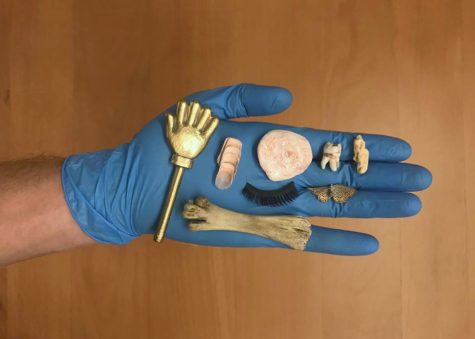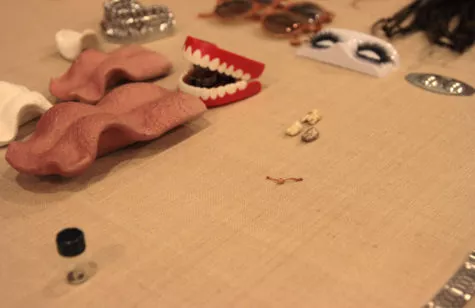ExposuresExposures: Adam Milner: Remains

Adam Milner holds an assortment of objects included in his installation.
Remains is an installation by Adam Milner, presented as part of The Andy Warhol Museum Exposures series. Honoring Andy Warhol’s early emergence in New York, the series features artists in Pittsburgh at the start of their careers.
The underwear were cuter than I had imagined, a little sexier. Pink Calvin Klein briefs. The subtle stains on them made them too real, more human than I had expected.
When I heard about the box of personal effects packed up by the hospital after Andy Warhol’s death and addressed to a non-existent Mrs. Warhol, my heart sank. Could anything be more vulnerable or intimate than the very things he carried on his back as he checked himself into the place he would die, the last things worn or touched by choice?
The box of his final effects contains his backpack, the clothes he wore (including the pink briefs), and his hospital bracelet. Among the items in the backpack are several pairs of eyeglasses, an electric shaver, his keys, echinacea, some perfume the color of whisky. Did he expect this would be a routine visit, that he’d be back to normal life in a few days? Or did he know this was the end of life as he knew it? I can’t fathom this feeling. I look at these things and I see a person all too real—tender, vulnerable, and possibly very scared.
The objects strike me not only for their obvious associations, but also because they bring up questions about archives in general. We know Warhol as the celebrity-obsessed artist who blurred his personal and professional life, centering his complex persona in his practice. The Time Capsules (1974–1987) further blur this line between life and art, converting personal detritus into an extended work, meant for conservation and museum exhibition. But what of all the other things in his home or this backpack? Who decided these things should become part of the half a million archived objects in the museum? As I stare at the underwear, I wonder where Andy’s body begins and ends, and who makes decisions surrounding how these parts and pieces (nearly phantom limbs) exist in the world.
Often, the things we interact with become part of us. Are clothes part of the body? Wigs? Actual hair? Contact lenses? Gum? The food in my stomach? An eyelash on your cheek? The body is a very porous thing, and it’s hard for me to draw the line between what’s part of it and what’s not. That’s, partially, why these items feel so intimate, like physical fragments of a person.

For Remains, I’ve treated The Warhol’s archives like an archaeological site, searching for and excavating Warhol’s body. I end up with more questions than answers. The items oscillate between feeling so specific and personal to seeming generic and mass produced. Other items feel strangely familiar, resembling items in my own home and studio (a lock of hair from a friend, crystals, dental molds). I find myself wondering: Do we have something special in common? Or does everyone have this stuff? Maybe Warhol just had so much of everything that such connections are inevitable—I’m not sure.

In this work, I’ve combined my personal things with his. I’ve included items from the Time Capsules and from the general archives, as well as Polaroid facsimiles. With an attention toward items related to the body, I’ve constructed a fragmented pair of figures in the archives section of the museum. Various dualities might come to mind with this pair (him and me, male and female, natural and fabricated), but such binaries blur and categories become complicated as our things intermingle. By working closely with museum staff to provide only hints of information about the identity of the objects, viewers encounter a compilation of items that they must make sense of themselves. Thus, the aura of Warhol hangs over the collective bodies, while each item is open for interpretation and up for interrogation. Items level out, and hair is hair, fingernails are fingernails, and underwear is still underwear.
Thank you to the entire staff at The Warhol for supporting this new project. I want to give a special thank you to Jessica Beck who noticed complicated relationships and kinships between mine and Warhol’s sensibilities—in our collecting habits, in our anxieties about the body, and in a quiet longing embedded in so much of the work. Without Jessica’s warm invitation to create this work and constant support throughout the process, it would not exist. I want to thank the archives department of the museum, specifically Erin Byrne and Matt Gray, for allowing this work to intersect with the archives so fundamentally and for being my guides and at times my literal hands and eyes sorting through the thousands of items in the archives. Their knowledge of the items in the archive was an invaluable resource crucial to the creation of this work.
Remains is on view on The Warhol’s third floor November 2, 2016–January 15, 2017. Milner discusses his installation Remains with Jessica Beck, The Warhol’s associate curator of art, during an artist talk on Saturday, November 5, 2016.